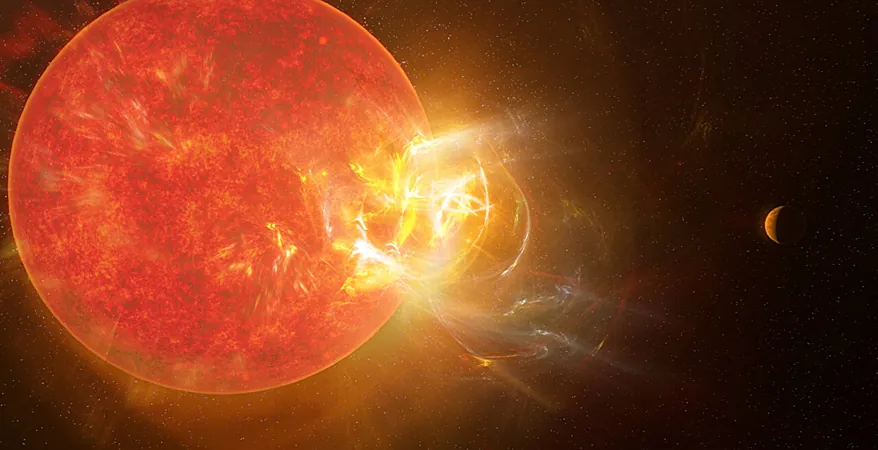
Unveiling Proxima Centauri: The Small Star with Intense Flare Activity!
2025-03-27
Author: Lok
Introduction
Astronomers have made groundbreaking discoveries about Proxima Centauri, our closest stellar neighbor located just over four light-years away. This M dwarf star has garnered attention for its remarkable activity, characterized by frequent and powerful solar flares. While its flare activity has been studied extensively using visible light, a new study conducted with the Atacama Large Millimeter/submillimeter Array (ALMA) has shed light on this fascinating star in radio and millimeter wavelengths. The findings promise to enhance our understanding of not just the flares themselves but also their potential consequences for any planets in a habitable zone around the star.
Significance of Flare Activity
Proxima Centauri is known to host a planet that might support life, making the impact of its active flare activity particularly significant. These stellar outbursts release an array of energies across the electromagnetic spectrum, along with bursts of energetic particles. Unlike the relatively mild flares of our Sun, which often produce beautiful auroras thanks to Earth’s protective atmosphere, Proxima Centauri's flares pose a more dire threat. The energy emanating from these intense flares could erode the atmospheres of its habitable-zone planets, stripping away vital components like ozone and water, thus rendering them inhospitable.
Research Study Overview
The research team, led by Kiana Burton from the University of Colorado and Meredith MacGregor from Johns Hopkins University, utilized both archival and new ALMA data for their study, which is now published in The Astrophysical Journal. Their investigations reveal that Proxima Centauri's compact structure and strong magnetic field contribute to its extreme activity. Unlike our Sun, which possesses both convective and nonconvective layers, Proxima Centauri's internal structure is entirely convective. This unique feature leads to a regular occurrence of powerful magnetic fields that store and release energy in a dramatic fashion, resulting in observable flares.
Key Insights and Observations
MacGregor emphasized the study's crucial question: "Our Sun's flares mainly create beautiful auroras without damaging our atmosphere due to its thickness and Earth's strong magnetic field. However, Proxima Centauri's powerful flares can significantly affect the rocky planets in its habitable zone. What exactly are these flares doing to the atmospheres of those planets? Are they chemically modifying them, or possibly eroding them completely?"
Data and Findings
This research marks a significant advancement in multi-wavelength studies, utilizing 50 hours of observations from ALMA’s full 12-meter array and the 7-meter Atacama Compact Array. During their investigations, astronomers recorded an astonishing 463 flare events, with energy levels ranging from 10^24 to 10^27 ergs. The flares themselves lasted a brief 3 to 16 seconds, showcasing the star's volatile behavior.
Flare Frequency Analysis
As MacGregor points out, "When we observe these flares through ALMA, we not only see the electromagnetic radiation but also gain valuable insights into the properties of the particles being expelled from the star." By examining the flare frequency distribution—mapping the number of flares based on their energy—researchers noted a typical power law function where smaller flares occur more frequently than larger ones. The number of flares observed is so high that the team found several events within each energy range, uniquely positioning Proxima Centauri as a highly active object of study.
Implications for Habitability
In light of this research, the potential implications for the habitability of planets around active stars like Proxima Centauri are profound. As we continue to explore the cosmos, understanding the dynamics of these stellar flares may be key to assessing the suitability of distant worlds for life, sparking the imaginations of astronomers and astrobiologists alike. Is Proxima Centauri home to worlds that could harbor life, or will its fierce flares render them desolate? Only time and further research will tell!



 Brasil (PT)
Brasil (PT)
 Canada (EN)
Canada (EN)
 Chile (ES)
Chile (ES)
 Česko (CS)
Česko (CS)
 대한민국 (KO)
대한민국 (KO)
 España (ES)
España (ES)
 France (FR)
France (FR)
 Hong Kong (EN)
Hong Kong (EN)
 Italia (IT)
Italia (IT)
 日本 (JA)
日本 (JA)
 Magyarország (HU)
Magyarország (HU)
 Norge (NO)
Norge (NO)
 Polska (PL)
Polska (PL)
 Schweiz (DE)
Schweiz (DE)
 Singapore (EN)
Singapore (EN)
 Sverige (SV)
Sverige (SV)
 Suomi (FI)
Suomi (FI)
 Türkiye (TR)
Türkiye (TR)
 الإمارات العربية المتحدة (AR)
الإمارات العربية المتحدة (AR)